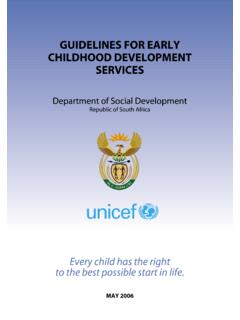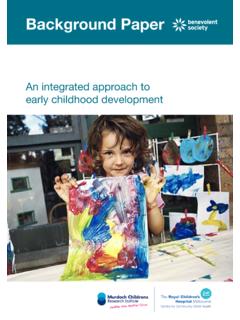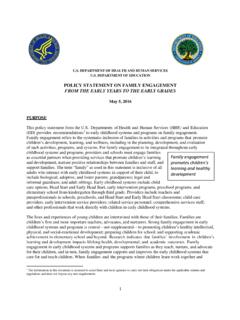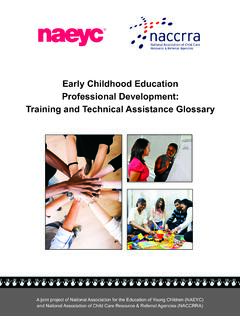Transcription of NATIONAL HEALTH SECTOR STRATEGIC PLAN - UNICEF
1 NATIONAL HEALTH SECTOR STRATEGIC PLANFOR early childhood development IN ETHIOPIA2020/21-2024/25 Ministry of HealthEthiopiaOctober 2020 Addis Ababa, EthiopiaNATIONAL HEALTH SECTOR STRATEGIC PLANFOR early childhood development IN ETHIOPIA2020/21-2024/25 Ministry of HealthEthiopiaOctober 2020 Addis Ababa, EthiopiaTable of ContentsAcknowledgement1 Foreword 2 Executive Summary 3 Abbreviations and Acronyms5 SECTION ONE: early childhood development Brain development The Nurturing Care Why to invest in Current landscape Rationale for the STRATEGIC plan Purpose of the NSP 14 SECTION TWO: NATIONAL GOALS AND STRATEGIC Vision Mission STRATEGIC Objectives of the NSP and beneficiaries principles 18 SECTION THREE: IMPLEMENTATION Fundamental STRATEGIC issues Priority activities for the next five years.
2 Intensity of care/interventions 21 SECTION FOUR: KEY STRATEGIC Governance and accountability: Organizational arrangement Service deliver platforms Mobilization and effective use of resources .Setting clear roles and responsibilities 28 SECTION FIVE: SPECIFIC STRATEGIES AND MAJOR STRATEGIC outcomes, outputs and activities 31 Reference421 AcknowledgementThe Ministry of HEALTH (MoH) would like to express its appreciation and gratitude to members of the early childhood development Technical Working Group (ECD-TWG), without whom the development and completion of this NATIONAL STRATEGIC plan for ECD would not have been possible. The MoH would also like to forward its deepest gratitude to the Ministry of Education (MoE), Ministry of Women, Children and Youth (MoWCY), UNICEF , WHO, World Bank, PATH, USAID, Children Believe and other partners for their unreserved support in the development of this STRATEGIC Meseret ZelalemDirector, RMNCAH-N Directorate, Ministry of HEALTH Ethiopia NATIONAL HEALTH SECTOR STRATEGIC Plan for early childhood development in Ethiopia2 Foreword Ethiopia has made impressive progress in achieving many of the NATIONAL and global HEALTH indicators as a result of strong leadership of the MoH, the coordination of efforts and intensive investment in the HEALTH system by the government, partners and the community at large.
3 Despite these achievements, the government of Ethiopia recognizes that the risk of poor developmental outcomes remains extremely high, affecting more than half of children under five years. Ethiopia initiated the early childhood Care and Education policy Framework in 2010, with a commitment to ensure that every child has a better start in life and to grow in a protective and stimulating environment. This policy framework was poorly operationalized and was revised in 2019 to make it comprehensive, by incorporating interventions for the holistic development of a child which had been overlooked and by exhaustively integrating ECD interventions into various existing NATIONAL HEALTH SECTOR STRATEGIC Plan for early childhood development (2020/21 2024/25) provides a detailed roadmap and framework for the HEALTH SECTOR , and ensures effective implementation of the NATIONAL ECD policy framework.
4 It does this by integrating nurturing care interventions for early childhood development which had been overlooked into existing maternal and child HEALTH and other HEALTH NATIONAL strategy, which will be part of the second HEALTH SECTOR Transformation Plan (HSTP II), aims to design and implement quality ECD programmes in order that all children grow and thrive in a secured, safe and nurturing environment. MoH will work with Regional HEALTH Bureaus (RHBs) and its development partners to ensure the implementation of quality ECD interventions. DugumaState Minister,ProgramMinistry of Health3 The past three decades have seen a considerable worldwide reduction in the mortality rate for children under the age of five. However, there is evidence showing that the risk of poor developmental outcomes remains extremely high, affecting an estimated 250 million (43%) children under five in low- and middle-income countries, and rising to over two-thirds of children in sub-Saharan Africa (Lancet Series 2017).
5 Children in low- and middle-income countries face interlocking challenges which can affect their HEALTH , wellbeing and learning throughout their lives. Long-term studies show that growth failure from conception to three years has a severe impact on adult HEALTH . A poor start in life hinders the ability of children to benefit from education, which can lead to lower productivity and social difficulties in the long term. An ECD programme is one of the best investments for a government which aspires for healthy, productive and prosperous citizens. In terms of direct economic benefits, recent evidence shows a 13 percent annual return on investment per child due to better education, economic, HEALTH and social outcomes among children under five years.
6 ECD is now a worldwide agenda, especially in low- and middle-income countries where a majority of young children face adversity in early life. Several UN organizations (WHO, UNICEF ) and the World Bank have designed policies and plans to support countries across the world promote ECD. The government of Ethiopia has long acknowledged the importance and value of investing in ECD, and is committed to designing and implementing a programme across the various sectors. The first cross-sectoral ECD policy and STRATEGIC plan was developed in 2010. Since then, MOH has been collaborating with other ministries in developing and ratifying an ECD policy , and in developing a SECTOR -specific STRATEGIC plan in order to better integrate the ECD programme into the wider HEALTH care system.
7 The NATIONAL ECD STRATEGIC plan 2020/21-2024/25 has been developed following the revision of the early childhood Care and Education policy Framework to the early childhood development , Care and Education (ECDE) policy Framework in 2019 by MoH, MoE and MoWCY. The purpose of this STRATEGIC plan is to provide a detailed roadmap and framework for the MoH in order to ensure the effective and integrated implementation of the NATIONAL ECD policy framework. Furthermore, it is designed to support the Sustainable development Goals (SDGs) agenda and the 2030 target for child HEALTH and wellbeing. Executive Summary NATIONAL HEALTH SECTOR STRATEGIC Plan for early childhood development in Ethiopia4 The goal of this NATIONAL ECD strategy is to design and implement programmes which ensure that all children grow and thrive in the secured, safe and nurturing environment which will promote their physical, intellectual, linguistic and social emotional development .
8 The strategy will be implemented in line with other relevant NATIONAL STRATEGIC plans including: HSTP II, Roadmap Towards Maximizing Newborn and Child survival and Wellbeing by 2030, NATIONAL Nutrition Programme, the EPI Comprehensive Multi-Year Plan, One WaSH NATIONAL Programme, iCCM and CBNC implementation plan. The strategy is also linked to the SDG agenda the commitment of the government of Ethiopia to ensure that all girls and boys have access to quality early childhood development , care and pre-primary education by 2030. 5 Abbreviations and AcronymsAIDSA cquired Immune Deficiency Syndrome ANCA ntenatal Care ECDE arly childhood development ECDEE arly childhood development and Education ECCEE arly childhood Care and EducationECD-TWGE arly childhood development -Technical Working Group EPIE xpanded Programme on Immunization FPFamily Planning HDAH ealth development ArmyHEPH ealth Extension Programme HEWH ealth Extension Workers HIVH uman Immunodeficiency VirusiECDI ntegrated early childhood development LMICsLow- and Middle-Income CountriesMoEMinistry of EducationMoHMinistry of HEALTH MoLSAM inistry of Labor and Social Affairs MoWCYM inistry of Women.
9 Children and YouthNCNurturing Care NCFN urturing Care Framework NSPN ational STRATEGIC Plan PAT HProgramme for Appropriate Technology in HealthPMTCTP revention of Mother to Child Transmission SDGS ustainable development GoalUNICEFU nited Nation Children s Fund USAIDU nited States Agency for International development WASHW ater Supply, Sanitation and HygieneWDAW omen development Army WHOW orld HEALTH OrganizationNational HEALTH SECTOR STRATEGIC Plan for early childhood development in Ethiopia601 SECTION ONE: early childhood development ECD is a process of continuous maturation in terms of cognitive, linguistic and executive functions, as well as mental, emotional and behavioral development in early childhood . early childhood represents the period from conception to six years of age (here after referred as young children ) and is critical for brain development .
10 The period is classified in three distinct stages: from conception to three years (during which HEALTH , nutrition and stimulation are essential for the rapidly growing brain); from three to five years (when special preschool care and education plays a pivotal role in the development and maturation of the child s brain); and five to six years (which is a critical time for school readiness). Most (80%) of the growth and development of the brain occurs in the first three years and this stage is a foundation for HEALTH and wellbeing later in , due to multiple factors including poverty, malnutrition, lack of basic services and limited scope for a nurturing environment, nearly half of children in LMICs are lagging behind in their full development potential.


















